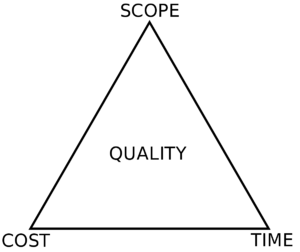The iron triangle as an analytical tool
Contents |
Abstract
This article aims to present the Iron Triangle (also known as Project Management Triangle, Project Triangle, and Triple Constraint Triangle) with a focus on Project Management through the perspective of Purpose. The Iron Triangle is an analytical tool based on the essential triple constraints of project management; Time, Cost, and Scope/Quality. While scope and quality cannot be directly interchangeable with each other, the choice of constraint definition varies through literature, whereas the PMI standards most often use Scope, and the British standards, Quality. This article is initially going to refer to the triple constraints including Scope, as PMI’s Project Management Body of Knowledge, a key reference of this article, uses this standard.
Regarding the application of the tool, PMI’s Project Management Body of Knowledge courses of action regarding the management of the triple constraints will firstly be briefly introduced. Then, various practical and strategic approaches to the application of the triple constraints will be presented. Here, the perspective of the Four Levels of Management (Managing Successful Projects with PRINCE2) will be included to illuminate how the Iron Triangle should not only be considered from a management perspective but also a delivering perspective. Lastly, it will be discussed how the Iron Triangle can be leveraged from representing a set of pre-defined specifications (classic view of projects) to an analytical tool focusing on value creation (state of the art view of projects) based on relevant success criteria. Here the methodology of conformance (value protection) vs. performance (value creation) will also be included.
Through above-presented observations, various limitations of the Iron Triangle will also inevitably emerge. These will be presented including varying takes on the Iron Triangle which could mitigate these limitations. Some of the limitations could be: The Iron Triangle does not include all constraints regarding project success. The perspective of which the constraints of the Iron Triangle are measured can have varying effects on the application of the tool. Also, even with the above-presented courses of action regarding the managing of constraints, the risk of unrealistic and uncertain measuring of the constraints could have critical consequences regarding the application of the tool.
Big idea
Test.
Application
Test.
Limitations
Test.
Annotated bibliography
Test.
Bibliography
Key references:
A guide to the Project Management Body of Knowledge (PMBOK guide), 6th Edition (2017)
Managing Successful Projects with PRINCE2, 6th Edition (2017)


